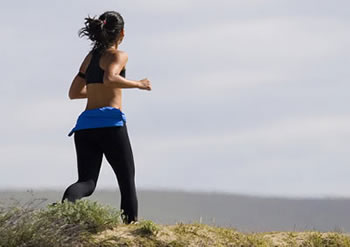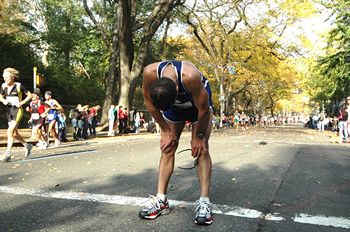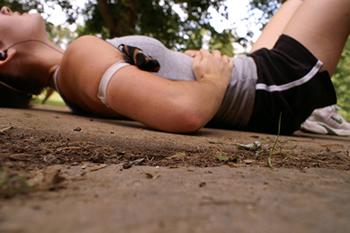RACE PERIOD
Ron Saetermoe
This is what it’s all been leading up to . . . your Race Period. This is when you give your training everything you’ve got. Your volume and intensity max during this period; and it is intense!
While “stuff happens” you really need to try to stay on task during this period. No slacking off now. You may be getting nervous about your race at this point and wondering if your training was adequate. If you’re a typical “A” type triathlon personality you’ll never feel like you’ve done everything you could have to prepare.
You must be very careful during this period NOT to over train, and to make sure you get plenty of rest on your recovery days. Too many athletes think that more is better and while you will be doing more volume you also need to get your rest or all of the hard work simply won’t take.
Go over the race on paper (or computer) and in your head. Review the website and any course maps, rules, directions, etc. Go to the race site in advance if you can and do the course.
I’m going to try to get a slot at IM St. George on May 1st so a bunch of us are going out to St. George to ride and run the course in March. This will give us an edge come race day.
You’ll either pull back on the resistance training or end it all together during this period – you’re probably totally ripped anyway by now! In addition, this phase includes the CRITICAL taper prior to your event.
The length of your taper will depend on the event you’re training for. Here’s what I like to do:
Sprint: 3 days
Olympic: 1 week
½ IM: 2 weeks
IM: 3 weeks
By now you should have your nutrition completely dialed in. Don’t change anything at this late date. Stay focused.
The key things about the Race Period are:
– Don’t miss workouts unless sick or injured
– Continue to increase your training volume and intensity
– Resistance (strength) training ends
– “Brick” workouts should be getting longer in distance
– Recovery is critical
– Taper
Here’s what the ideal Triathica year looks like:

Again, we feel that three, three-week cycles within each period is optimal for building fitness and recovery. The time to build strength, speed and endurance is upon you. Make the best of it!
Cheers!
Ron
BREAKING THROUGH A PLATEAU
Jarrett Pflieger

Triathletes are in a constant battle against themselves. We go out and train, beating up our bodies, with the knowledge that all our hard work will translate into adaptations that will enable us to swim, bike, and run faster and longer. There is no greater feeling than continuously going out and improving upon your performances from the weeks, months, and years previous.
Unfortunately, this feeling does not last forever. Every triathlete eventually hits a point where, no matter how hard they train; they can’t seem to improve even a small amount, if at all. This is known as a plateau and is common among all types of athletes. There are several reasons for this and ways to get around plateaus, so there’s no need to panic.
1. Stagnant Training Routines
Many of us like to stay in our comfort zones. We get into a comfortable training routine that we like and have shown us good performance gains in the past. Just because it has worked does not mean it will work forever. Your body is very good at adapting to outside stress, so if you maintain the same routine for months without switching things up, your body will stop responding to the stress and you will not see the gains you want.
To prevent this, you need to change things around every once and a while. When building a training plan, you need to vary not only distance, but also intensity, volume, rest periods, etc. A good periodized training plan should incorporate all these aspects and keep your body constantly guessing.
2. Poor Diet
Your body is a machine and it needs fuel to function properly. This is even more important for athletes. Your performance will reflect the kinds of food you put into it. You should stick with calorically dense foods like fruits, vegetables, complex carbohydrates (oatmeal, whole wheat, brown rice, quinoa, etc.) and lean protein (chicken, fish, lean beef, turkey).
Try to stay away from processed foods and sugars as much as you can. An occasional treat will not hurt, just stick with a 90/10 rule. Follow a sensible diet 90% of the time, and feel free to eat whatever you want 10% of the time, in moderation, of course.
3. Overtraining
The amount of rest you give your body is just as important as your training. Without proper rest, your body will not have time to absorb the training and make the adaptations that lead to increased performance. If you are constantly fatigued, sore, and/or not hitting your target times in training, there is a good chance you are not giving your body enough rest. Too much rest is better than too little. Just listen to your body and dial it back a few notches if you need to. In this case, less is more.
Although there are some reasons for plateaus that cannot be overcome (age, injury, genetics, etc.), most of the time all it takes is a small adjustment in training or lifestyle to keep the gains coming. Listen to your body, get a good coach, and you will continue setting PR’s and getting the most out of your training.
ABOUT THE “BONK”
Ron Saetermoe
 I’m an expert about the “bonk.” Ask me anything!
I’m an expert about the “bonk.” Ask me anything!
For example, did you know there are different kinds of bonk? Sure, you have the nutritional bonk, the cardio bonk, the muscular bonk and the run into the wall bonk. I’ve experienced all four varieties.
One of my Ironman mentors, Chris Johnson (qualified, and completed, 15 consecutive Ironman World Championships) purposely goes out and bonks. This gives him an idea of how hard he can push himself before he bonks. Aren’t we triathletes nutty?
The first time I experienced any kind of bonk was during my first marathon back in 1979. I had heard of “hitting the wall” but didn’t think there was anything you could do about it – it just happens. Of course, I didn’t know back then that it probably would have been a good idea to eat something or at least drink the Gatorade they had on the course.
I bonked in 2008 during my first Ironman: Ironman Coeur d’Alene. This was a muscular bonk. Not to say I wouldn’t have bonked anyway, but I wasn’t able to finish my training plan because I broke two ribs five weeks prior to my race. On second thought, let’s blame it on that.
I bonked again in 2008 at Ironman Arizona. This time it was a nutritional bonk. My personal problem when going hard is taking in anything solid, even gels. For some reason my stomach just doesn’t like anything solid. I had my gels and even made peanut butter and jelly sandwiches but couldn’t stomach any of them.
The bike portion of the race was fine but when I got to the run I was toast! I had nothing in the tank. My legs felt fine and my heart rate was fine but I had no energy. I started walking and was able to pick my pace up throughout the race only because I was able to take some calories in.
Last year Lar Dog, Larry Davidson, turned me on to Infinit. I mix it up to triple strength and sip it and chase it with water. Voila! No bonk! I’ve practiced and raced with it numerous times and not only don’t I bonk but I also don’t get hungry. Problem solved.
I’m sure there are plenty of other fine products out that can perform the same miracles, but for my money, Infinit is it!
BUILD PERIOD
Ron Saetermoe
Last week I discussed the Base Period of your training year, this week we move on to the next period, which is the Build Period.
Once you’ve finished with the Base Period your fitness should be quite good. Now you’re going to continue building your endurance and speed. Your training load increases and missed workouts should be avoided unless sick or injured.
You should still be hitting the gym during this period and increasing the effort in your resistance training. I generally do 10 different exercises in my resistance training – two sets of each exercise. You may be increasing your sets, reps, weight or all three.
Be sure you’re incorporating speed, power and endurance workouts in all three sports during this period, and don’t forget to continue doing bricks (swim/bike and/or bike/run).
During your long rides and runs be sure to test your nutrition and get it completely dialed in so you know what you’ll need to complete your race (if you’re doing the long stuff).
The key things about the Build Period are:
– Don’t miss workouts unless sick or injured
– You continue to increase your training volume and intensity
– Resistance (strength) training increases
– “Brick” workouts should be getting longer in distance
– Don’t forget to incorporate recovery days and weeks in your plan (your fitness takes hold when your body is at rest)
Here’s what the ideal Triathica year looks like:

Again, we feel that three, three-week cycles within each period is optimal for building fitness and recovery. The time to build strength, speed and endurance is upon you. Make the best of it!
Cheers!
Ron
EVERY RUNNERS NIGHTMARE: THE SIDE STITCH
Jarrett Pflieger
 Side stitches, cramps, whatever you want to call them, they hurt. Every runner, at one point of another, has had to battle through a side stitch during training or racing. The pain can become so bad it forces us to slow down, or in extreme cases, stop completely. What exactly causes these side stitches and are there ways to make them go away when they happen, or better yet, prevent them altogether?
Side stitches, cramps, whatever you want to call them, they hurt. Every runner, at one point of another, has had to battle through a side stitch during training or racing. The pain can become so bad it forces us to slow down, or in extreme cases, stop completely. What exactly causes these side stitches and are there ways to make them go away when they happen, or better yet, prevent them altogether?
A side stitch, technically known as exercise-related transient abdominal pain (ETAP), is not a buildup of gas or cramping of the abdominal muscles. It actually originates in the diaphragm, the muscle that helps you breathe and separates your organs from your chest cavity. You see, when you breathe in, your diaphragm naturally moves downward to increase the capacity of air your lungs can take in. As your diaphragm moves up during exhaling, it brings your organs up with it.
The problem is when you run, you have gravity working against you, even more so than when you’re standing still. When you take each stride while running, your organs are pulled down by gravity, but your exhaling causes your diaphragm to move up. These opposing forces cause the ligaments and muscles connecting your organs to your diaphragm to stretch, which is very painful. This phenomenon can then make your diaphragm to go into spasms, which causes the painful cramps we often experience.
Once a side stitch comes, it is hard to get rid of. You can try sticking a few fingers under your ribs to try to massage the muscles and ligaments. Deep breathing also helps get rid of the stitch faster, since shallow breathing usually prolongs the spasming. If all else fails, slow down or stop until the pain leaves. If you are made of steel and feel no pain, just push through it, the choice is yours.
One way to prevent side stitches completely is to change your breathing pattern. If you tend to exhale mostly when your right foot is hitting the ground, your large liver could be causing more pain as it is pulled away from your diaphragm. Organs are smaller on the left side, so try exhaling when on left foot strikes.
Proper hydration and warm-up is also key in preventing the side stitch. Dehydration, sodium deficiency, and cold muscles can make the side stitch come faster and be harder to get rid of. Hopefully you can implement some of these tips and say farewell to your side stitch woes for good.


